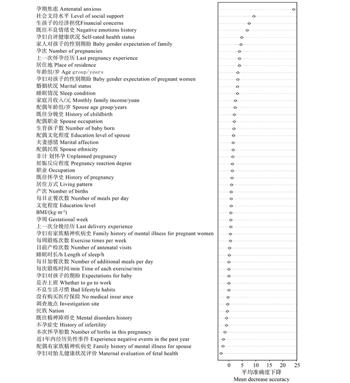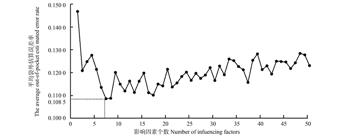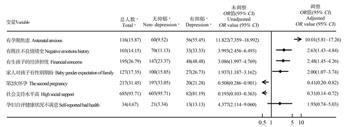| 基于随机森林算法和多因素logistic回归分析模型的孕期抑郁影响因素 |
| |
| 引用本文: | 邓淦元, 杨中婷, 杜兴梅, 邓春燕, 宋婷, 李瑞雨, 何杰宇, 邓睿, 黄源, 陈莹. 基于随机森林算法和多因素logistic回归分析模型的孕期抑郁影响因素[J]. 中华疾病控制杂志, 2023, 27(9): 1003-1009. doi: 10.16462/j.cnki.zhjbkz.2023.09.003 |
| |
| 作者姓名: | 邓淦元 杨中婷 杜兴梅 邓春燕 宋婷 李瑞雨 何杰宇 邓睿 黄源 陈莹 |
| |
| 作者单位: | 昆明医科大学公共卫生学院,昆明 650500 |
| |
| 基金项目: | 国家自然科学基金资助项目72264020 中华医学基金会资助项目CMB#19-338 云南省中青年学术和技术带头人后备人才项目202305AC160046 健康与危害量化测评博士生导师团队建设项目2022 |
| |
| 摘 要: | 
目的 分析孕期抑郁检出率探讨可能的影响因素,识别高危人群为预防抑郁症提供科学依据。 方法 对云南省某县2022年5月处于孕期的女性人群采用爱丁堡产后抑郁症量表(Edinburgh Postnatal Depression Scale,EPDS)进行抑郁筛查,利用随机森林算法对影响因素进行重要性排序,用滑动窗口序贯向前选择法降维,将重要性评分最高且平均袋外估算误差率最小的影响因素纳入多因素logistic回归分析模型,估计影响因素的作用方向及效应值。 结果 732名孕妇接受问卷筛查,孕期抑郁检出率为13.8%(101/732)。随机森林算法分析显示,变量数为7时平均袋外估算误差率最小。
将重要性排名前7的影响因素纳入多因素logistic回归分析模型,结果显示:孕期焦虑、既往不良情绪史、生孩子的经济担忧、家人对孩子有性别期盼是孕期抑郁的危险因素,第2次怀孕、高社会支持水平是孕期抑郁的保护因素,孕妇自评健康状况不满意与孕期抑郁无关。 结论 孕期有焦虑的女性很可能伴有抑郁,对生育费用、孩子性别的担忧和既往的不良情绪史会增加孕期抑郁的风险,足够的社会支持和既往的孕育史可以减少孕期抑郁发生的风险。建议加强孕期抑郁筛查,早期识别孕期抑郁症的高危人群。

|
| 关 键 词: | 孕期抑郁 随机森林算法 多因素logistic回归分析模型 影响因素 |
| 收稿时间: | 2022-12-12 |
| 修稿时间: | 2023-03-21 |
|
| 点击此处可从《中华疾病控制杂志》浏览原始摘要信息 |
|
点击此处可从《中华疾病控制杂志》下载全文 |
|



